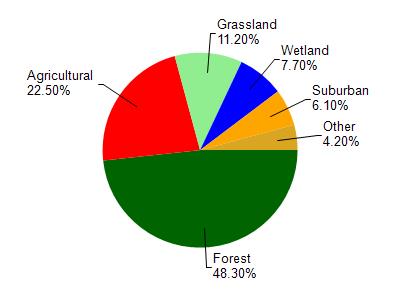Sauk
No
No
No
Fish and Aquatic Life
Overview
Blass Lake was created in 1929 by impounding Springbrook Creek just outside of Lake Delton. It is a 34-acre hyper-eutrophic lake with poor water quality and excessive algae and aquatic plant growth. The lake has a good panfish, largemouth bass and northern pike fishery.
Date 2002
Author Aquatic Biologist
Historical Description
Blass Lake is an impoundment of Spring Brook above Lake Delton. It is a hypereutrophic
lake with poor water quality (WDNR, 1991).
Date 1994
Author Surface Water Inventory Of Wisconsin
Historical Description
Source: 1971, Surface Water Resources of Sauk County Blass Lake, T13N R6E, Sec. 17, 20
A drainage lake created by a dam with a 16-foot head on Spring Brook one mile west of the City of Lake Delton. The dam was constructed in 1929 across the deep gorge through which Spring Brook flows. The watershed area of the lake totals 6.14 square miles and Spring Brook is an intermittent stream during the dry summer months. Largemouth bass, northern pike and panfish comprise the major sport fishery. Aquatic vegetation is a major use problem and a fish kill caused by chemical spraying to control the problem occurred in 1958. Game assets found on the lake and surrounding shores include whitetailed deer, squirrels, ruffed grouse and puddle ducks. Many private cottages, a Jewish Community Center, and a Senior Citizens Resort are located along the shores. A controversy arose in 1962 as to whether the lake was public or private due to the fact that all surrounding land was in private ownership. It was officially determined to be a public lake and a walk-in gravel path and boat landing pier was proposed on the northwestern shore in 1970 by the Town of Delton. Interstate 90-94 also provides access to the lake by a widening of the Spring Brook inlet.
Surface area 34.4 acres, S.D.F. = 2.15, maximum depth 17 feet.
Date 1971
Author Surface Water Inventory Of Wisconsin
Condition
Wisconsin has over 84,000 miles of streams, 15,000 lakes and milllions of acres of wetlands. Assessing the condition of this vast amount of water is challenging. The state's water monitoring program uses a media-based, cross-program approach to analyze water condition. An updated monitoring strategy (2015-2020) is now available. Compliance with Clean Water Act fishable, swimmable standards are located in the Executive Summary of Water Condition in 2018. See also the 'monitoring and projects' tab.
Reports
Recommendations
Aquatic Plant Management Plan
update
Informational Meetings
Aquatic Plant Monitoring or Survey
summer plant survey will be conducted, voucher specimens of plant species present will be preserved
Management Goals
Wisconsin's Water Quality Standards provide qualitative and quantitative goals for waters that are protective of Fishable, Swimmable conditions [Learn more]. Waters that do not meet water quality standards are considered impaired and restoration actions are planned and carried out until the water is once again fishable and swimmable
Management goals can include creation or implementation of a Total Maximum Daily Load analysis, a Nine Key Element Plan, or other restoration work, education and outreach and more. If specific recommendations exist for this water, they will be displayed below online.
Monitoring
Monitoring the condition of a river, stream, or lake includes gathering physical, chemical, biological, and habitat data. Comprehensive studies often gather all these parameters in great detail, while lighter assessment events will involve sampling physical, chemical and biological data such as macroinvertebrates. Aquatic macroinvertebrates and fish communities integrate watershed or catchment condition, providing great insight into overall ecosystem health. Chemical and habitat parameters tell researchers more about human induced problems including contaminated runoff, point source dischargers, or habitat issues that foster or limit the potential of aquatic communities to thrive in a given area. Wisconsin's Water Monitoring Strategy was recenty updated.
Grants and Management Projects
Monitoring Projects
| WBIC | Official Waterbody Name | Station ID | Station Name | Earliest Fieldwork Date | Latest Fieldwork Date | View Station | View Data |
|---|
| 1295800 | Blass Lake | 10019844 | Lake Blass -- Access | 6/25/2012 | 9/30/2013 | Map | Data |
| 1295800 | Blass Lake | 10005447 | Lake Blass | 7/27/1999 | 7/5/2023 | Map | Data |
| 1295800 | Blass Lake | 573054 | Blass Lake - Deep Hole | 7/1/1980 | 8/4/2009 | Map | Data |
| 1295800 | Blass Lake | 573075 | Lake Blass at Lake Delton WI | | | Map | Data |
|

Watershed Characteristics
Blass Lake is located in the Dell Creek watershed which is 133.73 mi². Land use in the watershed is primarily forest (48.30%), agricultural (22.50%) and a mix of grassland (11.20%) and other uses (18.00%). This watershed has 231.97 stream miles, 193.10 lake acres and 4,715.88 wetland acres.
Nonpoint Source Characteristics
This watershed is ranked High for runoff impacts on streams, Medium for runoff impacts on lakes and High for runoff impacts on groundwater and therefore has an overall rank of High. This value can be used in ranking the watershed or individual waterbodies for grant funding under state and county programs.However, all waters are affected by diffuse pollutant sources regardless of initial water quality. Applications for specific runoff projects under state or county grant programs may be pursued. For more information, go to surface water program grants.